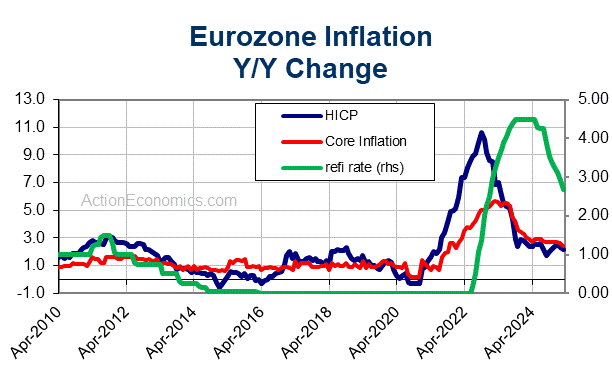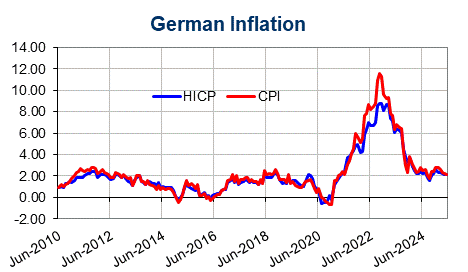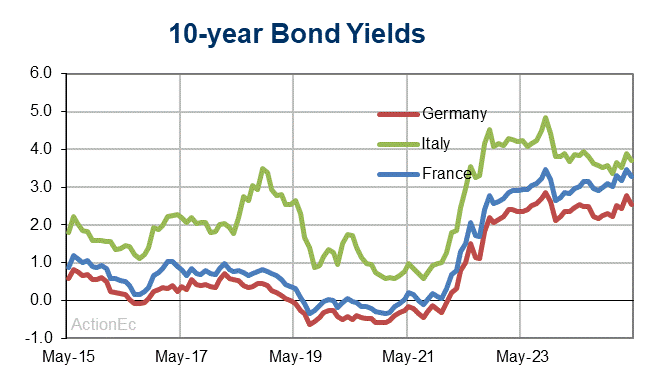Eurozone inflation may have come down again in July, but as the ECB flagged in its latest economic bulletin, the outlook for inflation remains highly uncertain, as does the outlook for growth. Wage growth remains high, and while longer inflation expectations have remained stable, market-based indicators of inflation risks have picked up again, as oil and gas prices spiked. On top of this, the impact of government measures to dampen the impact of the Ukraine war continues to muddle the picture.
Eurozone HICP inflation dropped back to 5.3% y/y in the preliminary reading for July, from 5.5% y/y in the previous month. Core inflation held steady at 5.5% y/y and is still higher than the headline, as services price inflation accelerated to 5.6% y/y from 5.4% y/y in June. At 5.5% y/y, core inflation remains more than twice the ECB’s target, and the central bank’s problem is also that the data reflects a number of special factors — first and foremost official attempts to limit the impact of the energy crisis last year and the cut-off from cheap Russian gas supplies.
Spain in particular took quicker and decisive action to keep a lid on prices. Energy prices were capped, the cost of public transport lowered, excess profits taxed, and restrictions were placed on rent increases by landlords. As a result, Spain’s HICP numbers have been undershooting the Eurozone average decisively in recent months, and even after a renewed pick up in the annual rate last month it was still just 2.1% y/y — i.e. only fractionally above the ECB’s target. However, no government can afford to keep costly support measures in place forever. And in Germany, the introduction of cheap public rail tickets over the summer of 2022 is now a key factor keeping core and headline inflation higher than the Eurozone average.

With official measures muddling inflation numbers it is even more important to focus on underlying inflation pressures, and the ECB in today’s economic bulletin laid out a number of alternative approaches to gauge developments. The Supercore indicator, which comprises cyclically sensitive HICP items, dropped to 6.0% y/y in June from 6.2% in May. The model-based Persistent and Common Component of Inflation (PCCI), which is expressed in terms of an annualized rate, also declined further at the end of the first half of the year (regardless of whether energy is included). The ECB’s overall assessment was that “recent developments in these measures suggest a turning point in underlying inflation pressures”. However, the ECB also stressed that “the range of monitored underlying inflation measures remains wide and at an elevated level, reflecting still high uncertainty and highlighting the need to monitor a broad set of data.”
Wage growth in particular has become a focus in recent months, as a tight labour market and a sharp rise in inflation underpinned wage demands. Actual wage growth, which is measured in compensation per employee and compensation per hour, diverged markedly during the pandemic as governments stepped in to try and allow companies to hang on to skilled staff even as production slowed. Similar effects were seen during the height of the energy crisis last year. Data for the first quarter of the year showed a sharp increase and a narrowing of the gap as compensation per employee rose to 5.4% from 4.9% y/y, while compensation per hour rose 4.8% y/y, after rising 4.2% y/y in the last quarter of 2022. Looking ahead, the ECB’s report of its contact with companies outside of the financial sector suggested a deceleration of wage increases next year. However, around half of contacts still expect wage growth in 2024 to be similar to 2023.

The question for the ECB is also to what extent companies are passing on higher wage costs, and the survey at least suggested that overall the decline in demand and the drop in non-labour input cost pressures meant that it has become more difficult for manufacturers and retailers of consumer goods to increase prices. Price growth across the services sector has remained high though, and the ECB survey flagged that “exceptional price growth in the tourism and hospitality sectors, driven by strongly recovering post-pandemic demand, was showing no sign of abating”.
The jury is still out then on second round effects, though at least there are signs that inflation expectations are not picking up. The ECB’s survey of professional forecasters showed longer-term inflation expectations at 2.0%, and the Survey of Monetary Analysts also reported median expectations steady at 2.0%. Consumer expectations for inflation three years ahead actually declined to 2.3% from 2.5%, according to the latest ECB survey, which is still above the central bank’s target, though it is going in the right direction.
The ECB did acknowledge that market-based measures of inflation compensation have picked up. Most recent data show they are still on the rise, with a number of reports this week flagging the uptick in the so called five-year, five-year forward inflation swap. It stood at almost 2.6% at the time the ECB’s economic bulletin was concluded, and hit 2.66% this week, despite the recent decline in headline inflation numbers. However, while this measure was a key indicator for Draghi in his assessment of deflation risks, it seems to have somewhat dropped in importance for the ECB. The bulletin today flagged that “market-based measures of inflation compensation are not a direct gauge of market participants’ genuine inflation expectations”, but also include inflation risk premia.

The ECB concluded that “when cleansed for risk premia, market pricing continues to indicate a more optimistic inflation scenario over the next two years than the one suggested by the June 2023 Eurosystem staff macroeconomic projections for the euro area”. Inflation risk premia meanwhile are likely to have picked up this week, in tandem with the rise in oil and gas prices and up-trends in world food prices.
Oil prices have bounced more than 10% over the past month, thanks to extended OPEC+ output cuts, but most recently also due to the renewed escalation of tensions in the Black Sea. The Ukraine has stepped up drone attacks in what looks like a bid to disrupt Russia’s oil exports. So far oil loading operations seem to be continuing, and Bloomberg flagged that tankers haven’t fled the region so far, but the Ukraine warned last Friday that Russia’s Black Sea ports should now be viewed as subject to “military threat”. Russia in turn has focused on targets critical to Ukraine’s grain export after ending the Black Sea Grain Initiative. Some are accusing Moscow of deliberately trying to push up global food prices again.
For the Eurozone’s inflation outlook, this means that the ECB cannot rely on external inflation pressures to continue to decline. So far the correction in energy prices has been helping to bring headline HICP down, but with oil prices picking up, this trend could change, especially if diverging growth expectations put pressure on EURUSD and exacerbate the impact of rising oil prices. On top of this, the decline in gas prices has also come to an end, and European gas futures jumped 30% this week amid the threat of industrial action at key LNG facilities in Australia. Assessing the inflation outlook remains difficult then, and this backs the ECB’s decision to keep all options on the table for September.
Click here to access our Economic Calendar
Andria Pichidi
Market Analyst
Disclaimer: This material is provided as a general marketing communication for information purposes only and does not constitute an independent investment research. Nothing in this communication contains, or should be considered as containing, an investment advice or an investment recommendation or a solicitation for the purpose of buying or selling of any financial instrument. All information provided is gathered from reputable sources and any information containing an indication of past performance is not a guarantee or reliable indicator of future performance. Users acknowledge that any investment in Leveraged Products is characterized by a certain degree of uncertainty and that any investment of this nature involves a high level of risk for which the users are solely responsible and liable. We assume no liability for any loss arising from any investment made based on the information provided in this communication. This communication must not be reproduced or further distributed without our prior written permission.
